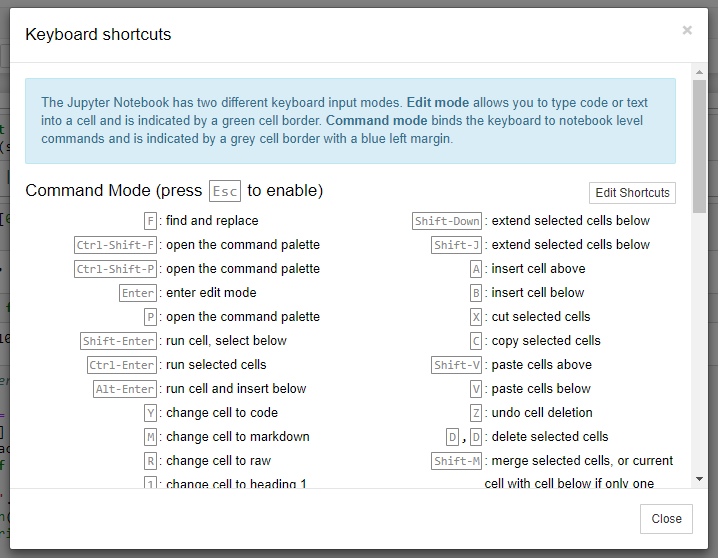
Different modes in a Jupyter Notebook. Jupyter Notebooks are a modal in nature, which means, the same keystroke behaves differently in different modes.There are mainly two modes in Jupyter Notebook. They are: Edit Mode. Edit mode allows you to type code/text into a cell just like an Editor and is indicated by a green bordered cell.To enter the Edit mode, press ENTER key in the keyboard. Do you use Jupyter a lot? I sure do, and I've gotten pretty good at doing so, thanks to a bunch of shortcuts that it provides. In this video, I show you my f.
- Jupyter Tutorial
- IPython
- Jupyter
- QtConsole
- JupyterLab
- Jupyter Resources
- Selected Reading
While the menu bar and toolbar lets you perform various operations on notebook, it is desirable to be able to use keyboard shortcuts to perform them quickly.
Jupyter Notebooks have two different keyboard input modes −
Command Mode − Binds the keyboard to notebook level actions. Indicated by a grey cell border with a blue left margin.
Edit Mode − When you are typing in a cell. Indicated by a green cell border.
Command Mode (press Esc to enable)
F | find and replace | 1 | change cell to heading 1 |
Ctrl-Shift-F | open the command palette | 2 | change cell to heading 2 |
Ctrl-Shift-P | open the command palette | 3 | change cell to heading 3 |
Enter | enter edit mode | 4 | change cell to heading 4 |
P | open the command palette | 5 | change cell to heading 5 |
Shift-Enter | run cell, select below | 6 | change cell to heading 6 |
Ctrl-Enter | run selected cells | A | insert cell above |
Alt-Enter | run cell and insert below | B | insert cell below |
Y | change cell to code | X | cut selected cells |
M | change cell to markdown | C | copy selected cells |
R | change cell to raw | V | paste cells below |
K | select cell above | Z | undo cell deletion |
Up | select cell above | D,D | delete selected cells |
Down | select cell below | Shift-M | merge selected cells, or current cell with cell below if only one cell is selected |
J | select cell below | Shift-V | paste cells above |
Shift-K | extend selected cells above | L | toggle line numbers |
Shift-Up | extend selected cells above | O | toggle output of selected cells |
Shift-Down | extend selected cells below | Shift-O | toggle output scrolling of selected cells |
Shift-J | extend selected cells below | I,I | interrupt the kernel |
Ctrl-S | Save and Checkpoint | 0,0 | restart the kernel (with dialog) |
S | Save and Checkpoint | Esc | close the pager |
Shift-L | toggles line numbers in all cells, and persist the setting | Q | close the pager |
Shift-Space | scroll notebook up | Space | scroll notebook down |
Edit Mode (press Enter to enable)
Tab | code completion or indent | Ctrl-Home | go to cell start |
Shift-Tab | tooltip | Ctrl-Up | go to cell start |
Ctrl-] | indent | Ctrl-End | go to cell end |
Ctrl-[ | dedent | Ctrl-Down | go to cell end |
Ctrl-A | select all | Ctrl-Left | go one word left |
Ctrl-Z | undo | Ctrl-Right | go one word right |
Ctrl-/ | comment | Ctrl-M | enter command mode |
Ctrl-D | delete whole line | Ctrl-Shift-F | open the command palette |
Ctrl-U | undo selection | Ctrl-Shift-P | open the command palette |
Insert | toggle overwrite flag | Esc | enter command mode |
Ctrl-Backspace | delete word before | Ctrl-Y | redo |
Ctrl-Delete | delete word after | Alt-U | redo selection |
Shift-Enter | run cell, select below | Ctrl-Shift-Minus | split cell at cursor |
Ctrl-Enter | run selected cells | Down | move cursor down |
Alt-Enter | run cell and insert below | Up | move cursor up |
Ctrl-S | Save and Checkpoint |
Centering Text in IPython notebook markdown/heading cells?
jupyter notebook markdown table alignment
markdown center text
jupyter markdown shortcut
jupyter markdown new line
how to edit a markdown cell in jupyter notebook
jupyter notebook markdown comment
jupyter markdown right align
I want to customize my notebook, make it more readable and stylish. So for that, I want to start with centering my headers. Is it possible?
You can actually use the markdown mode for the cell and use the normal HTML code, as in
Centering Headings in IPython notebook, If you want to center a heading without custom css, you can surround your text with center tags. For example, if you wanted to make a centered Markdown cell displays text which can be formatted using markdown language. In order to enter a text which should not be treated as code by Notebook server, it must be first converted as markdown cell either from cell menu or by using keyboard shortcut M while in command mode. The In[] prompt before cell disappears. Header cell. A markdown cell can display header text of 6 sizes, similar to HTML headers.
Not directly with markdown i think, but you can just enter HTML in the markdown cells:
Markdown in Jupyter Notebook, Markdown cells can be selected in Jupyter Notebook by using the the bold with centered text along with table heading is described by <th> is small typo prevented the previous implementation from working, but this one should be better – It actually uses markdown to format the tag itself, so nothing that doesn't already work in a markdown header will be allowed.

Keyboard Shortcuts For Jupyter Notebook
Knowing that in jupyter (ipython) notebook markdown cells the title level is identified by the number of # (# for top level headings or h1, ## for h2, ....), I use the following combination of HTML and markdown:
# <center>Your centered level h1 title</center>
## <center>Your centered level h2 title</center>
etc..
It's straightforward and the easiest to remember but please do comment if there's any disadvantage in doing so.
Tested in jupyter version 4.4.0 (not sure about other version but no reason it doesn't work).
Jupyter Notebook – Markdown Example -2 – BIG IS NEXT- ANAND, Table of Contents Headers Emphasis Lists Links Images Code and Syntax leading spaces (at least one, but we'll use three here to also align the raw Markdown). Here's our logo (hover to see the title text): Inline-style: 
Jupyter Notebook Shortcuts Windows
For example, you can use the following commands to play with your texts:
1.**bold_text** will make your test bold like bold_text.2.*italic_text* will result in italic text like italic_text3.***bold_italic_text*** will result in bold and italic text like bold_italic_text 4. You can use <h1> header1 </h1> to make the text as header like
header1
You can replace h1 within the angular brackets with any number h2,h3 etc. to get header of different sizes.5. For text alignment you can use Centered_text to align you text to the center.6. Use<br> to breakline or if you want the following text to be printed in next line.These are just basic things, you can do many more things.
Markdown Cells, Normally in Jupyter Notebook, the cell type will be code by default. Internal & External Link (Hyperlink): Markdown text starting with http or https automatically or das (-) symbol is used to make alignment between columns. As with Markdown cells, a heading cell is replaced by a rich text rendering of the heading when the cell is executed. Basic workflow ¶ The normal workflow in a notebook is, then, quite similar to a standard IPython session, with the difference that you can edit cells in-place multiple times until you obtain the desired results, rather than
Markdown table alignment · Issue #3024 · jupyter/notebook · GitHub, Hi, I want to change the alignment in Jupyter notebooks. The HTML in markdown cells is sanitized, and that includes stripping off style Here’s how to format Markdown cells in Jupyter notebooks in the IBM Data Science Experience. Headings: Use #s followed by a blank space for notebook titles and section headings: # title ## major
justified text in markdown cells · Issue #2796 · jupyter/notebook , The short version is, that i wanted to format my markdown text fields as markdown cell is somehow differently 'tagt' for the text-align: justify; I would be great to have a spellchecker in text cells: headings and markdown cells Currently in Chrome and Firefox under Linux I have the 'native' browser spellchecker not working. I think the problem is that Codemirror is filtering the cell content to not be spellcheked, but I would be great to have it functional
The Ultimate Markdown Guide (for Jupyter Notebook), Therefore, the formatting syntax of Markdown tackles just issues that can be Recall that a Jupyter Notebook is a series of cells that can store text or code. after each text, roughly aligning with the columns will do just fine. Markdown Cells¶ Text can be added to Jupyter Notebooks using Markdown cells. You can change the cell type to Markdown by using the Cell menu, the toolbar, or the key shortcut m .
Hot Questions
